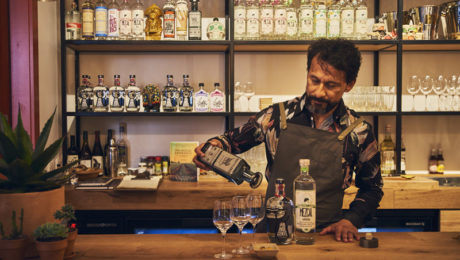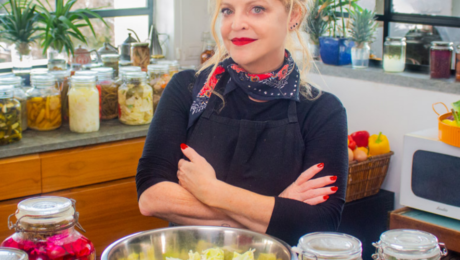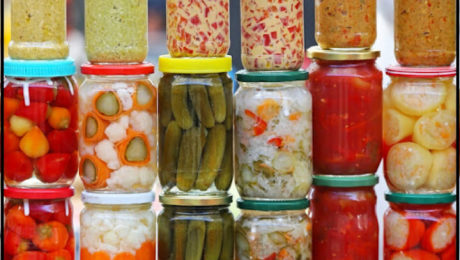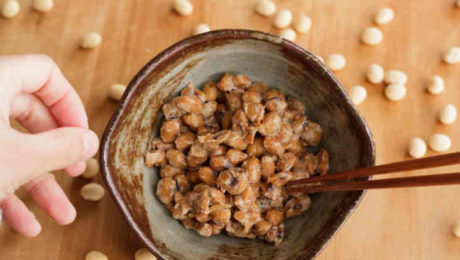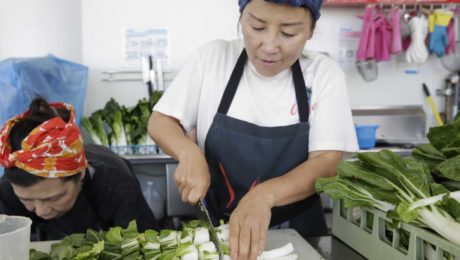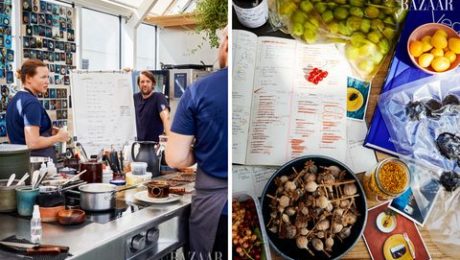Mezcal “Like Kissing Mother Earth”
Edmundo Farrera describes the taste of mezcal as a complex experience: “First you taste the valley where the agave plant was grown, next the earth it came from, and then on to taste the cosmos and time.”
The Veracruz, Mexico native who opened New Zealand’s first mezcal bar says each sip of a great mezcal is “so beautiful and powerful, like pyrotechnics exploding on my palate.”
An ancient drink that dates back to the Aztecs, they agave was eaten and used in ceremonies. Mezcal came about after the colonization in Mexico by Spainards. They brought Filipino slaves with them, who shared distillation techniques with the Aztecas.
Farrera says mezcal has long been popular in America but only recently it’s becoming more popular globally. American foods and sommeliers, he notes “are fascinated, even more than us, with these agave spirits. They get into it, they study it, a good percentage of American sommeliers, like with wine, can recognise different species of agave in a blind tasting of mezcal.”
He advises “a real mezcal drinker will never touch a cocktail.” Mezcal should be enjoyed sip-by-sip, he says, with the first sip awakening the palate and the second sip experiencing the multi-dimensional taste.
Read more (Stuff)
- Published in Uncategorized
Serial Pickler’s Pickling Prowess
Israel scientific magazine ISRAEL21c got a tour of Noa Berman-Herzberg’s pickle paradise in her home kitchen. Berman-Herzberg, who uses the moniker Serial Pickler, has garnered a large following online (64,000 Instagram followers).
Pickling first piqued her interest when her grandparents ran a Jewish deli in Philly. Today she is a fermentation education and screenwriter, producing the culinary storytelling project “Sour Food, Sour Stories” where her guests talk with Berman-Herzberg while eating her pickles. They must each tell a story about something they felt they missed out on life (the Heber word for pickle means “missed out on.”).
Her unusual ferments and pickle pairings have attracted the attention of chefs from around the world. At any given time Berman-Herzberg has 100 different pickle varieties at home, from a fiery pineapple pickle to a pickle with a miso-coffee spread.
“To taste these fruits and vegetables is to feel you have landed the golden ticket to a Willy Wonka land of pickles. Flavors and textures are exciting and unexpected,” the article reads.
When Berman-Herzberg began, she says most people thought she was a “weirdo.” Today, she believes pickles have found their moment.
“We need to rethink the way we prepare food,” she says. “Preservation is going to be especially important as we head into a future of food shortages and climate change.”
Read more (ISRAEL21c)
- Published in Food & Flavor
“Dairy is Ripe for Innovation”
As the dairy industry continues to suffer from low sales, could fermentation help the industry meet changing consumer needs? Functional dairy products (like fermented dairy) and animal-free precision fermentation products are major consumer trends for the dairy industry to adapt.
Functional dairy products are “ripe for expansion,” said Brad Schwan, vice president of Archer-Daniels-Midland Company, said brands have to invest in alt protein technologies to feed the future tech-savvy generation. Fermented dairy – like yogurt, kefir and fresh cheese – are all functional dairy.Fifty-eight percent of global consumers perceive a connection between gut function and other aspects of well-being. Consumers are looking for dairy with simple ingredient lists.
“The gut microbiome is a key growth area for functional, tailored offerings, as more consumers are making the link between their gut, digestive health and overall well-being,” Schwan added.
Consumers are looking for dairy with simple ingredient lists. They want their dairy to support pre- and post-workout goals, energy solutions, hydration, digestive support and immune function.
More consumers are embracing a mix of an animal- and plant-based diet. Fifty-two percent of consumers eat a flexitarian diet now.
Alt protein – once seen as a fringe biotechnology – is becoming more mainstream. Brad Schwan, vice president of Archer-Daniels-Midland Company, said brands have to invest in alt protein technologies to feed the future tech-savvy generation.
“While consumer acceptance of alternative solutions beyond plant proteins is still building, we foresee digital-natives Gen Z and Gen Alpha leading the way in the growing acceptance of novel methods and technologies,” he said in a report on global food trends. “Additionally, the dairy industry is ripe for more innovation in the coming year, through leveraging both new technologies…As consumers grow more accustomed to seeing novel proteins from unexpected places, the alternative dairy arena will flourish with new possibilities.”
Read more (Dairy Reporter)
- Published in Business
Fermented Foods Reduce Stress
Researchers have made a breakthrough discovery in stress management: fermented food can change one’s mood.
Scientists from the University College Cork (UCC) APC Microbiome research center found consuming 2-3 servings of fermented foods a day – like sauerkraut, kefir, kimchi, kombucha, yogurt, etc. – improves mental health. Stress and depressive symptoms are reduced when regularly consuming fermented foods.
Their month-long study analyzed the effects of a psychobiotic diet on adults, while the control group was given general nutrition advice in line with the food pyramid. The psychobiotic diet is designed to target the gut microbiome. It includes fermented foods, fruit and vegetables high in prebiotic fibers, grains and legumes.
“Although the microbiome has been linked to stress and behavior previously, it was unclear if by feeding these microbes demonstrable effects could be seen,” said Professor John Cryan, one of the study’s lead authors, vice president for research and innovation at UCC, and a principal investigator at APC Microbiome. “Our study provides one of the first data in the interaction between diet, microbiota and feelings of stress and mood. Using microbiota targeted diets to positively modulate gut-brain communication holds possibilities for the reduction of stress and stress-associated disorders, but additional research is warranted to investigate underlying mechanisms.”
Researchers studied participants with relatively low fiber diets, measuring their perceived levels of stress before and after beginning the psychobiotic diet. Four weeks in, participants reported a strong decrease in perceived stress. Their sleep improved, too. Forty chemicals were affected by the change,
“These results highlight that dietary approaches can be used to reduce perceived stress in a human cohort. Using microbiota-targeted diets to positively modulate gut-brain communication holds possibilities for the reduction of stress and stress-associated disorders,” the study reads.
Cryan, in an article for The Telegraph, said: “The mechanisms underpinning the effect of diet on mental health are still not fully understood. But one explanation for this link could be via the relationship between our brain and our microbiome (the trillions of bacteria that live in our gut). Known as the gut-brain axis, this allows the brain and gut to be in constant communication with each other, allowing essential body functions such as digestion and appetite to happen.
“It also means that the emotional and cognitive centres in our brain are closely connected to our gut.”
He added: “The next time you’re feeling particularly stressed, perhaps you’ll want to think more carefully about what you plan on eating for lunch or dinner. Including more fibre and fermented foods for a few weeks may just help you feel a little less stressed out.”
The study was published in Molecular Psychiatrry.
Pass the Protein Powder – and the Ferments?
Fermented foods can aid in muscle growth.
“A growing body of research suggests gut-friendly foods enhance muscle growth and could even take a bite out of age-related decline,” reads an article in Men’s Health.
As we age, the body slows down, reflexes decrease and muscle mass decline — especially difficult changes for professional athletes. The average person loses 5% of muscle mass per decade after reaching 30, leading to diminished mobility and heightened risk of falls. Exercising consistently is key to keep muscles strong. But equally important, research shows, is maintaining a healthy gut microbiome. New research – published in the journal Nutrition and Metabolic Insights – found mice with an artificially depleted microbiome from antibiotics had significantly slower muscle growth than the control group.
“In short, muscles really are built in the kitchen – at least, to a greater degree than you might have suspected,” the article continues.
The article points to the ground-breaking Stanford study that found a diet high in fermented foods boost microbiome diversity. The article concluded with four fermented food swaps “to make your gains last.” These include: swapping yogurt for kefir, swapping green beans for natto, swapping pickles for kimchi and swapping ketchup for miso.
Read more (Men’s Health)
- Published in Business
SF’s Vegan Kimchi Queen
Aruna Lee’s path to running a fermented food brand is riveting, from her journey as an orphan to Buddhist nun to founder of Volcano Kimchi.
Lee’s story is detailed in a San Francisco Chronicle feature. Adopted by her teacher, she remembers sneaking out of bed in the middle of the night and digging up dongchimi, a winter radish kimchi fermented in large crocks buried in the ground. Later, as a nun in seminary school, Kimchi was communally made during gimjang, the process of kimchi making. The members of the monastery would prepare bulk batches in winter and spring in a large bathtub, storing it in underground crocks.
Curious about the world, Lee later left the monastery and traveled the world. She met her husband and eventually made roots in San Francisco. After the recession forced her to leave her career in the nonprofit sector, she began making kimchi for sale at farmers markets in 2014 without any professional cooking experience. Her organic kimchi is made similarly to how she learned in the monastery — including keeping it vegan.
“When you add fish sauce and shrimp paste, it overpowers everything and you don’t taste each ingredient. When you add simple ingredients, it’s balanced. It has a harmony of that flavor,” Lee says.
Read more (San Francisco Chronicle)
- Published in Business, Food & Flavor
Replacing Meat
Popular Science advises it’s time people swap animal protein for fungi. The article focuses on the environmental benefits of fermented meat alternatives, as they could help cut deforestation.
A recent study published in Nature estimates annual deforestation may be cut in half if 20% of per-capita meat consumption is substituted with microbial protein by 2050. This substitution would offset the expected increase in CO2 emissions in pasture areas around the globe.
“The production of ruminant meat requires large areas for cattle grazing or growing its feed on cropland, which causes deforestation, biodiversity loss, and CO2 emissions,” says Florian Humpenöder, study author and senior scientist at the Potsdam Institute for Climate Impact Research. “Today, almost 80 percent of global agricultural land including cropland and pasture is used for feeding livestock.”
Popular Science points out a difficult truth: though microbial protein uses far less land and much lower greenhouse gas emissions compared to traditional meat, “its energy consumption is almost equal to that of beef production. The entire process of microbial meat production — which includes electricity generation, microbial cultivation, bioreactor stirring and cooling, and the eventual downstream processing of biomass and proteins — requires energy.”
Lutz Grossmann, assistant professor in the Department of Food Science at the University of Massachusetts Amherst, says this cultivation process needs to be designed sustainably. Humpenöder suggests electricity generation needs to be decarbonized on a large scale, and renewable energy sources should be considered in alternative meat production. If this doesn’t happen, substituting microbial protein for traditional animal meat will not lead to a decrease in energy-related greenhouse gas emissions.
Read more (Popular Science)
- Published in Business
Using Genomics to Improve Beer
A group of Belgian scientists have not only identified the gene responsible for much of the flavor of beer and other alcoholic beverages, they’ve also engineered it for brewers.
By screening large numbers of yeast strains, researchers were able to identify the genes responsible for beer’s flavor.
“To our surprise, we identified a single mutation in the MDS3 gene, which codes for a regulator apparently involved in production of isoamyl acetate, the source of the banana-like flavor that was responsible for most of the pressure tolerance in this specific yeast strain,” said Johan Thevelein, Ph.D., an emeritus professor of Molecular Cell Biology at Katholieke Universiteit, and one of the researchers. His team pioneered the technology that identifies the genes responsible for commercially important traits in yeast.
Important to the study was finding the gene successful at creating flavor on a commercial scale. Modern, large-scale beer brewers use tall, cylindrical fermentation tanks compared to the traditional shorter vats. While the taller tanks are easier for brewing, it negatively impacts the beer’s taste. That’s because, when beer ferments, the yeast coverts 50% of the sugar in the mash to ethanol and the other 50% to carbon dioxide. But carbon dioxide pressurizes in the modern closed vessels, dampening flavor.
Using the gene editing technology CRISPR/Cas9, Thevelein and his team were able to engineer the MDS3 gene for other brewing strains, improving their tolerance of carbon dioxide pressure and improving the flavor.
“That demonstrated the scientific relevance of our findings, and their commercial potential,” Thevelein added in a statement.
“The mutation is the first insight into understanding the mechanism by which high carbon dioxide pressure may compromise beer flavor production,” said Thevelein, who noted that the MDS3 protein is likely a component of an important regulatory pathway that may play a role in carbon dioxide inhibition of banana flavor production, adding, “how it does that is not clear.”
The technology has also been successful in identifying genetic elements important for rose flavor production by yeast in alcoholic drinks, as well as other commercially important traits, such as glycerol production and thermotolerance.
The results of their study were published in Applied and Environmental Biology, the journal for the American Society for Microbiology.
- Published in Science
Organization Necessary for Creativity at Noma
Beautiful photos of the “farm to table mecca” Noma graced the pages of this month’s Harper’s Bazaar, with an accompanying article interviewing chef-owner Rene Redezepi and R&D head Mette Brink Søberg. The Nordic restaurant has come to redefine modern fine dining as using local and seasonal ingredients.
When Noma started, Redzepi says the challenge was how to serve Nordic food year-round, even in the harsh climate of Copenhagen.
“I thought to myself, why are we trying to serve a tasting menu with a little bit of everything as opposed to what’s really good when it’s available?” Redzepi says.
Noma’s tasting menu is divided into three cycles – plant-based in the summer, wild game and foraged mushrooms in fall and local fishermen’s hal in the winter. Noma’s test kitchen is in a greenhouse next to the garden, “we are very connected to the seasons and can pick flowers and leaves to use on the menu right at our doorstep,” Søberg says.
Redzepi says necessary to their creativity is organization. They make a list of ingredients and techniques they’d like to employ, make deadlines and use pictures as a frame of reference. “We keep meticulous records of finished dishes,” he says.
“In the beginning of the creative process, it is important to allow ourselves to spend time working on those ideas that might at first glance seem impossible or ridiculous, because even if they might not end up on the menu, they could lead to something that we would have never come across if we hadn’t sacrificed the time,” Søberg adds. “Often the most innovative and original elements on the menu have many weeks and sometimes months of work behind them.
Read more (Harper’s Bazaar)
- Published in Food & Flavor
Bean-free Chocolate & Coffee
The front page of the Financial Times featured a new wave of alternative foods: chocolate and coffee, but without the beans.
Cultivating both cocoa beans for chocolate and coffee cherries for coffee at such a high rate for global consumption is damaging to the environment. It’s linked to deforestation. The working conditions for many of the farmers are also deplorable, with child and slave labor and poor wages. Now multiple startups are trying to make a market for bean-free products.
“You realise that a lot of our favourite foods, whether it’s beef burgers or a cult of coffee or a chocolate bar, there’s so much damage,” said Johnny Drain, chief technology officer of WNWN Food Labs, a London-based maker of cocoa-free chocolate. “Not just to the climate but to the people, typically in developing countries who are producing those products for us.”
Drain is a fermentation expert who formerly worked with restaurants to make unique flavor profiles using fermentation. He’s founded WNWN with Ahrum Pak, a former financier now working in the foodtech space with Drain (both pictured). Their chocolate is made from fermented barley and carob.
More startups are, too, trying to be a solution to an unhealthy chocolate and coffee industry. In Munich, Planet A developed a cocoa-free chocolate which has chief ingredients of fermented oats and sugar beet. They call it “Nocoa.” In the U.S., Voyage Foods and California Culture make chocolate from lab-grown cocoa.
Bean-free coffee, meanwhile, has been created by two U.S. startups – Atomo in Seattle uses date seeds, chicory root, grape skin and green tea to create a canned cold brew coffee. Compound Foods in San Francisco. The latter is recreating coffee using synthetic biology and fermentation.
“We want to give consumers a choice,” said Andy Kleitsch, co-founder of Atomo, who added that although they had been worried that “the coffee industry would hate us or that the baristas might hate us, the reception has been positive”.
Many of these entrepreneurs note alt products are not the only solution to an environmentally-damaging food industry. Drain adds: “It’s just one additional way of trying to change an industry that is built on inequity and slave labour.”
Read more (Financial Times)
- Published in Business, Food & Flavor

